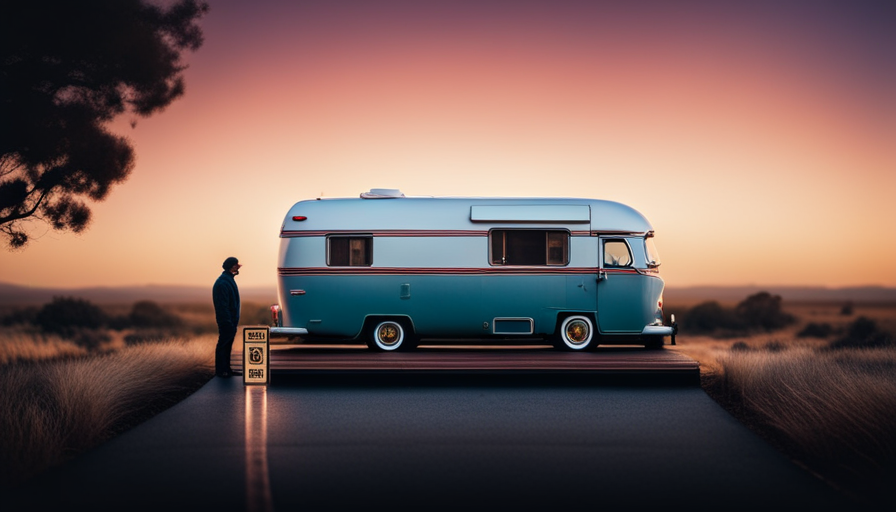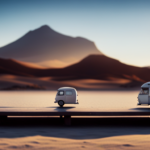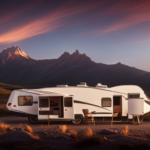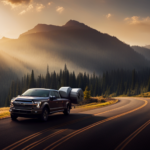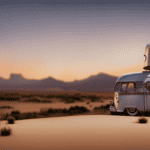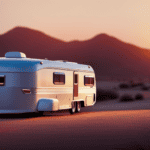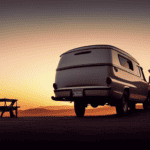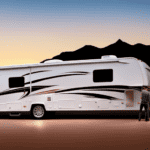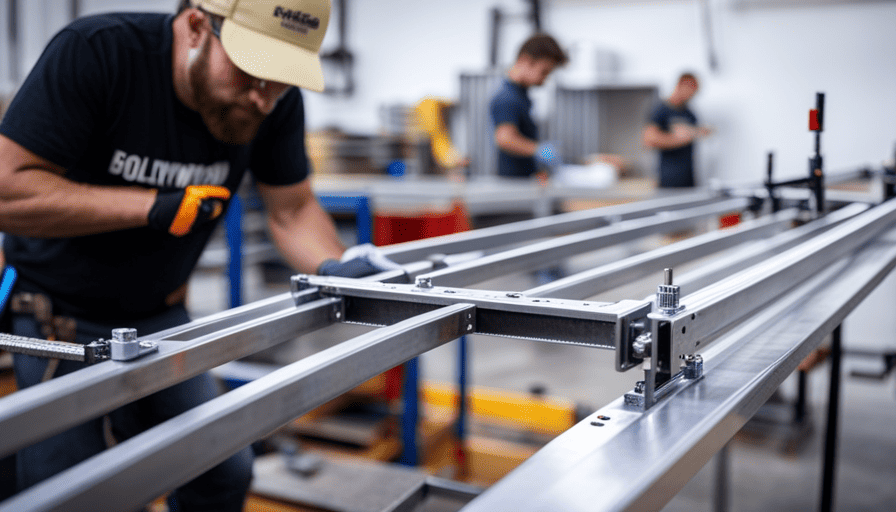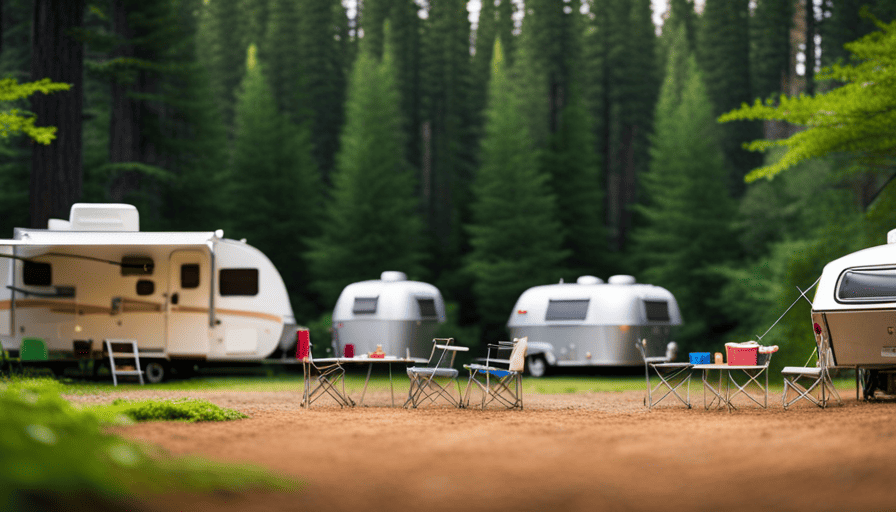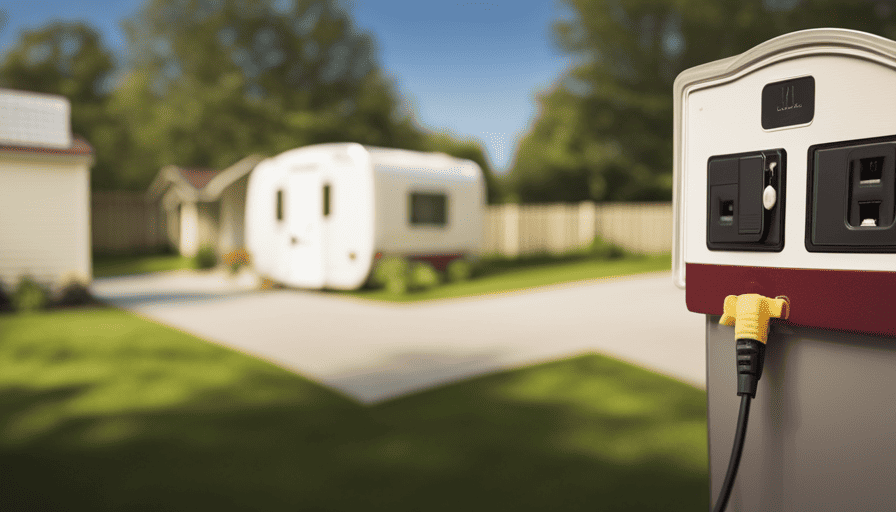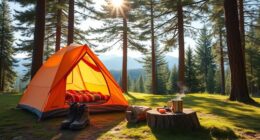Imagine this scenario: you’re preparing for an exciting journey, eager to discover the beauty of nature while traveling in your own camper. However, before you start your adventure, it’s crucial to grasp the concept of GVWR.
Like the foundation of a sturdy tent, GVWR forms the backbone of your camper’s capabilities. So, what exactly is GVWR? It stands for Gross Vehicle Weight Rating, and it’s the maximum weight that your camper can safely carry, including passengers, cargo, and fluids.
Understanding GVWR is crucial for selecting the right camper that suits your needs, ensuring safety on the road, and staying within legal limits. In this article, we’ll delve into the definition and significance of GVWR, factors that affect it, and the potential consequences of overloading.
We’ll also provide tips for determining the GVWR you require and choosing the perfect camper. So, let’s dive in and uncover the secrets behind the GVWR on a camper!
Key Takeaways
- GVWR stands for Gross Vehicle Weight Rating and is the maximum weight a camper can safely carry.
- Exceeding GVWR can cause mechanical issues and safety hazards.
- GVWR is different from payload capacity, which only considers the weight of passengers and cargo.
- Adhering to GVWR is important for the safety of the camper and its occupants.
Understanding the Basics of GVWR
If you’re wondering what GVWR stands for on your camper, we’ve got the scoop to make it easy for you to understand!
GVWR stands for Gross Vehicle Weight Rating, and it refers to the maximum weight that your camper can safely handle, including the weight of the camper itself, its occupants, and all the cargo inside.
The GVWR is determined by the manufacturer and is an important factor to consider when it comes to the overall safety and performance of your camper.
Calculating the GVWR involves taking into account various factors such as the weight of the camper’s frame, axles, suspension, and tires.
It is crucial to stay within the GVWR limits to ensure proper weight distribution and prevent overloading, which can lead to poor handling, increased stopping distances, and potential damage to the camper’s components.
Understanding the importance of GVWR in camper selection is vital. It ensures that you choose a camper that can safely accommodate your needs without exceeding its weight limits.
By selecting a camper with a GVWR that matches your requirements, you can enjoy a comfortable and safe camping experience.
So, let’s dive into the next section and explore why GVWR is crucial when it comes to selecting the right camper for you.
Importance of GVWR in Camper Selection
When you’re choosing a camper, it’s important to consider the maximum weight capacity of the vehicle, as it’s like trying to fit a square peg in a round hole – you’ll end up with a lot of unnecessary stress and frustration. Evaluating weight distribution in camper selection is crucial to ensure a smooth and safe journey. Here are five key factors to keep in mind:
-
Payload Capacity: This refers to the maximum weight that the camper can carry, including passengers, luggage, and any additional equipment. It’s important to choose a camper with a payload capacity that can accommodate your needs.
-
Tongue Weight: This is the downward force exerted on the hitch ball by the camper’s tongue. It’s vital to consider the tongue weight to maintain proper balance and stability while towing.
-
Towing Capacity: The towing capacity of your vehicle determines the maximum weight it can safely tow. Make sure to choose a camper that falls within your vehicle’s towing capacity to avoid straining the engine and compromising safety.
-
Gross Vehicle Weight Rating (GVWR): This is the maximum weight that a fully loaded camper can safely weigh, including its own weight and the weight of all passengers, cargo, and fluids. Exceeding the GVWR can lead to mechanical issues and safety hazards.
-
Axle Capacity: Each axle on the camper has a specific weight capacity. It’s essential to ensure that your camper’s axle capacities are suitable for the weight you plan to carry.
Considering these factors will help you make an informed decision when selecting a camper that aligns with your vehicle’s capabilities. Understanding the definition and significance of GVWR will further enhance your knowledge on this matter.
Definition and Significance of GVWR
Understanding the importance of GVWR is crucial for a smooth and safe journey in selecting the right camper.
GVWR, or Gross Vehicle Weight Rating, refers to the maximum weight that a vehicle, such as a camper, can safely carry, including the weight of the vehicle itself, passengers, cargo, and any towing capacity. It is essential to understand GVWR limits as exceeding this weight can lead to serious safety issues, such as poor handling, increased braking distance, and potential damage to the vehicle’s suspension and braking systems.
GVWR is different from payload capacity, which only considers the weight of passengers and cargo. While payload capacity refers to the maximum weight that can be carried in the vehicle’s cabin and cargo area, GVWR takes into account the total weight of the vehicle and its contents. Therefore, it is crucial to consider both GVWR and payload capacity when selecting a camper to ensure that you don’t exceed the vehicle’s capabilities.
Factors such as the type of camper, size, and the number of passengers can affect the GVWR. Additionally, the weight of any additional equipment, such as generators or propane tanks, should also be considered. Understanding these factors will help you make an informed decision when selecting a camper that fits within the GVWR limits.
With this understanding, you can embark on your journey confidently, knowing that you’ve chosen a camper that is safe and suitable for your needs.
Factors Affecting GVWR
To ensure you don’t go over the weight limit, keep in mind factors like the size of your ride and the number of passengers you plan to bring along on your road trip. These factors play a crucial role in determining the Gross Vehicle Weight Rating (GVWR) of your camper.
GVWR is the maximum weight that your camper can safely carry, including the weight of the vehicle itself, passengers, cargo, and any modifications.
Factors affecting weight distribution also impact the GVWR. For example, if you have a larger camper, it will have a higher GVWR compared to a smaller one. Additionally, the number of passengers you plan to bring along will affect the weight distribution and should be considered when calculating the GVWR.
It’s important to note that modifications to your camper can also affect the GVWR. Adding extra features or equipment can increase the weight and potentially exceed the GVWR, compromising the safety of your ride. Therefore, it is crucial to carefully consider the impact of any modifications on the GVWR before making changes to your camper.
Considering these factors will help you stay within the weight limit and ensure a safe and enjoyable road trip.
Moving on to safety considerations related to GVWR, it is important to understand the importance of adhering to this weight limit for the well-being of your camper and its occupants.
Safety Considerations Related to GVWR
Make sure you prioritize safety by adhering to the weight limit of your vehicle and considering the well-being of your passengers and yourself.
When it comes to campers, safety measures are crucial, and understanding the GVWR plays a significant role. The GVWR indicates the maximum weight that your camper can safely carry, including its own weight, passengers, and cargo. Exceeding this limit can put excessive strain on the vehicle’s components, leading to potential mechanical failures and compromising your safety on the road.
To ensure safety, it’s essential to distribute the weight evenly throughout the camper. Uneven weight distribution can affect the stability and handling of the vehicle, especially during turns or sudden stops. You should avoid overloading one side or the rear of the camper to maintain proper balance. Additionally, make sure that heavy items are properly secured to prevent them from shifting during travel, as this can also impact the vehicle’s stability.
By following these safety measures and considering weight distribution, you can help prevent accidents and keep yourself and your passengers safe while on the road.
Now, let’s transition into calculating the GVWR for your camper and understanding how it impacts your overall towing capacity.
Calculating the GVWR for Your Camper
Now that we understand the safety considerations related to the GVWR of a camper, let’s dive into calculating the GVWR for your specific camper. It’s crucial to know the GVWR as it determines the maximum weight your camper can safely carry, ensuring a smooth and secure journey.
There are several methods to calculate the GVWR of your camper. One common method is to start with the empty weight of the camper, also known as the ‘dry weight,’ and then add the weight of all the items you plan to carry, including water, fuel, and personal belongings. Another approach is to consult the manufacturer’s specifications, which usually provide the GVWR for your specific camper model.
When calculating the GVWR, it’s important to consider the towing capacity of your vehicle as well. Comparing the GVWR of your camper to the towing capacity of your vehicle will help ensure that you can safely tow the camper without exceeding the limits of your vehicle.
Understanding the GVWR calculation methods and comparing the GVWR to your vehicle’s towing capacity will give you confidence in knowing that you are within the recommended weight limits for a safe and enjoyable camping trip.
Moving forward, let’s explore the legal requirements and regulations for GVWR to ensure we’re fully informed about the standards we need to meet.
Legal Requirements and Regulations for GVWR
Understanding the legal requirements and regulations for GVWR will ensure you’re compliant and prioritize the safety of your camping experience.
It’s important to be aware of GVWR limits, as exceeding them can have serious legal implications. GVWR, or Gross Vehicle Weight Rating, is the maximum weight that a camper can safely carry, including passengers, cargo, and fluids. This weight limit is determined by the manufacturer and is essential for maintaining the structural integrity and stability of the camper.
Exceeding the GVWR can lead to significant consequences. Firstly, it can compromise the safety of your camper and increase the risk of accidents. Overloading puts excessive strain on the tires, suspension, and brakes, which can result in tire blowouts, reduced braking efficiency, and even loss of control while driving.
Additionally, exceeding the GVWR can result in fines and penalties. Law enforcement agencies often conduct weight inspections, especially for larger campers, and being found in violation of the weight limits can lead to hefty fines and even the impoundment of your camper.
Understanding the legal implications of exceeding the GVWR is crucial for a safe and enjoyable camping experience. However, it’s also essential to be aware of the potential consequences of overloading the GVWR, as it can have a detrimental impact on both your safety and your wallet.
Potential Consequences of Overloading the GVWR
Piling on too much weight can precipitate problematic performance and pricey penalties. When it comes to camper trailers, exceeding the Gross Vehicle Weight Rating (GVWR) can have serious consequences. The GVWR is the maximum weight that a camper can safely carry, including the weight of the trailer itself, its cargo, and all occupants. Exceeding this weight limit can lead to a variety of negative outcomes.
One of the main consequences of overloading the GVWR is compromised performance. The camper may struggle to accelerate, brake, or maneuver properly. This can put a strain on the vehicle’s engine, transmission, and braking system, potentially leading to mechanical failures and increased fuel consumption. Additionally, an overloaded camper may experience excessive swaying and instability, making it difficult to control on the road.
In addition to performance issues, overloading the GVWR can result in costly penalties. Many jurisdictions have strict regulations regarding weight limits for vehicles, and exceeding these limits can lead to fines and citations. Furthermore, insurance companies may deny coverage for accidents or damages caused by an overloaded camper.
To ensure that you don’t face these consequences, it’s important to determine the GVWR for your specific needs. This involves considering the weight of your cargo, including water, propane, and personal belongings, as well as the weight of any additional equipment or modifications. By properly assessing your needs and adhering to the weight limits, you can enjoy a safe and worry-free camping experience.
How to Determine the GVWR for Your Specific Needs
To figure out the perfect weight limit for your specific needs, you can simply assess the weight of your cargo, including water, propane, and personal belongings, as well as any additional equipment or modifications you plan to bring along. Calculating the Gross Vehicle Weight Rating (GVWR) is crucial to ensure you don’t exceed the legal regulations and compromise your safety on the road.
First, gather all the items you plan to take with you on your camping trips, including food, clothing, and recreational equipment. Make a list and estimate their weights. Don’t forget to include the weight of water and propane, as they can add significant pounds.
Next, consider any modifications or additional equipment you’ll be installing, such as bike racks or solar panels. Add their weights to your list.
Once you have a comprehensive list, add up all the weights to get the total. This total weight should not exceed the GVWR specified by the manufacturer of your camper. Exceeding this weight limit can lead to serious consequences, such as reduced braking ability, strain on tires, and potential damage to the vehicle’s suspension and frame.
With a clear understanding of how to calculate the GVWR for your camper, you can now move on to the next step of choosing the right camper based on your GVWR requirements. This will ensure you have a safe and enjoyable camping experience without compromising your vehicle’s performance.
Tips for Choosing the Right Camper Based on GVWR Requirements
When choosing the perfect camper for your needs, it’s essential to consider your weight requirements to ensure a safe and enjoyable camping experience.
One common mistake to avoid when considering GVWR for camper selection is underestimating the weight of your belongings and passengers. It’s important to factor in not only the weight of your camping gear but also the weight of any additional items you may bring along on your trips. This will help you determine the GVWR that is suitable for your needs.
Another important aspect to understand is the relationship between GVWR and towing capacity for campers. The GVWR refers to the maximum weight limit that a camper can safely handle, including its own weight and the weight of all its contents. On the other hand, towing capacity refers to the maximum weight that a vehicle can safely tow. It’s crucial to ensure that your vehicle’s towing capacity is higher than the GVWR of the camper you choose. Exceeding the towing capacity can put excessive strain on your vehicle and compromise safety.
To choose the right camper based on GVWR requirements, carefully consider the weight of your belongings and passengers, and ensure that your vehicle’s towing capacity is sufficient. Taking these factors into account will help you avoid common mistakes and ensure a safe and enjoyable camping experience.
Frequently Asked Questions
What are the different factors that contribute to the GVWR of a camper?
When considering the factors that contribute to the GVWR of a camper, several key elements come into play. These include the weight of the camper itself, the weight of any additional equipment or supplies, and the weight of the passengers and their belongings.
It’s crucial to understand the importance of GVWR in camper safety, as exceeding this limit can lead to decreased control, increased stopping distance, and potential damage to the vehicle and its components.
Can I exceed the GVWR of my camper if I am only traveling a short distance?
Yes, it’s important to understand that you can’t exceed the GVWR (Gross Vehicle Weight Rating) of a camper, even for short distance travel. The GVWR is determined by various factors, such as the camper’s structural design, axle ratings, and suspension system. Exceeding this weight limit can lead to reduced control, increased braking distances, and potential damage to the camper’s components. It’s crucial to always prioritize safety and adhere to the recommended weight limits to ensure a smooth and secure journey.
Are there any penalties or fines for exceeding the GVWR of a camper?
Exceeding the GVWR of a camper can lead to potential consequences such as fines, penalties, and even safety hazards. To avoid this, it’s crucial to properly manage the weight of your camper.
Start by knowing the GVWR and never exceed it. Regularly check the weight distribution, ensuring it’s evenly distributed and not concentrated in one area. Remove unnecessary items and pack only essential belongings. Additionally, consider upgrading your suspension or tires if needed.
Always prioritize safety and adhere to weight limits.
How often should I check the GVWR of my camper to ensure I am not exceeding it?
To ensure we’re not exceeding the GVWR of our camper, it’s important to regularly check and calculate its weight. One popular adage that comes to mind is ‘measure twice, cut once.’
By periodically weighing our camper and comparing it to the GVWR, we can identify any signs of overloading, such as sagging suspension, difficulty steering, or uneven tire wear.
By staying proactive and mindful of our camper’s weight, we can ensure a safe and enjoyable journey.
Are there any safety features or technologies that can help prevent overloading the GVWR of a camper?
There are several safety features and technologies available that can help prevent overloading the GVWR of a camper. Many newer models come equipped with weight distribution systems, which help evenly distribute the weight across the axles.
Additionally, some campers have built-in sensors that monitor the weight and alert you if you’re approaching the GVWR limit. It’s important to take advantage of these features and regularly check the weight of your camper to ensure you’re within the safe limits.
Is the Black Tank on a Camper Related to the Gross Vehicle Weight Rating (GVWR)?
Yes, the black tank in a camper is indeed related to the Gross Vehicle Weight Rating (GVWR). The black tank is responsible for holding and managing waste, including toilet waste, within the camper. Since the weight of the waste can affect the overall weight of the camper, it becomes a factor in determining the GVWR. Therefore, it is essential to consider the capacity and weight of the black tank while calculating the GVWR of a camper.
Conclusion
In conclusion, understanding the GVWR of a camper is crucial for a safe and enjoyable travel experience. By knowing the weight capacity and limitations of your camper, you can ensure that you select the right one for your specific needs.
Remember, exceeding the GVWR can lead to serious consequences, both in terms of safety and legal issues. So, take the time to research and choose a camper that meets your requirements, and always prioritize safety on the road.
Happy camping!

